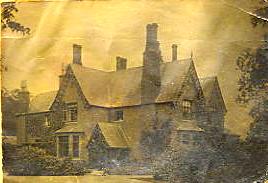When the decision was taken in 1846 to build a church in Leverstock Green, plans also included a typical Victorian Vicarage to house the incumbent, and the Earl of Verulam was kind enough to donate the land for both. Though not directly adjacent, the Vicarage, designed like the church by the Brandon brothers, was only a short step from Holy Trinity, at the end of Pancake Lane. Church & Vicarage alike both cost about £2,000 to build.
In Kelly’s directory of 1870, the vicarage, which provided the living for the incumbent Robert Helme, was given the yearly value of £95 and was in the gift of the Earl of Verulam. Sixteen years later, however, it had increased somewhat in value and Kelly’s noted the "living is a vicarage with a tithe rent charge of £42", with a "net yearly value of £260, including 3 acres of glebe, with residence, in the gift of trustees."
The earliest pictures we have of part of the vicarage date from the latter part of the 19th century during the incumbency of George Finch (1871-1899). One shows the Rev. Finch’s carriage drawn up outside the front of the Vicarage, whereas the other one shows the front of the Vicarage itself, but is a very old and grimy photograph, which I’ve attempted to enhance digitally.
However, a commercial postcard taken in about 1900 (left) gives us a very clear idea of what the house was like within its 3 acres of grounds as it was taken from the back and shows the then tennis court within the grounds.
It was these grounds which included a meadow, which were the location for the annual Sunday School treat, camps for the Girl Guides and Boy Scouts, and several pageants over the years and in 1909 it was also the venue for an Al Fresco Concert:
A very enjoyable al fresco concert in aid of the Leverstock Green Parish Room Fund was held in the Vicarage Gardens on Tuesday evening. The pretty and picturesque grounds were tastefully decorated for the occasion with a profusion of lags, and when the shades of night had fallen a charming scene was presented by the countless fairy lamps and Chinese lanterns, with which the ground were illuminated. The vicar devoted much time and energy to the arrangements, and there is no doubt that his efforts were crowned with success.
In the summer of 1919 the Vicarage grounds were the scene of the most ambitious project to date, with a Missionary Pageant, written by the Vicar’s daughter Lorna. This was a tremendous success and was later to be repeated at Southills. (See http://www.lgchronicle.net/MPageant.html & 1919 & 1920)
A new Vicarage or Rectory, more in keeping size wise for a modern family, was built within the grounds in 1940, and it is from this time on that the property, now sold off as a private residence, became known as Danehurst, reputedly after the Great Dane belonging to its then owner Cavan O’Connor, “The Strolling Vagabond”. See http://www.lgchronicle.net/CavanOConnor.html Cavan O’Connor was to sell on Danehurst to another personality, ROBERT (BOB) EDWARDS, the editor of the Daily Express.
Danehurst’s final owner was John Powell and his family, to whom I am greatly indebted for much information and numerous photographs. The Powells moved into Danehurst in October 1964, when it was well on the way to falling into ruin. The contract for sale insisted that it be no longer referred to as the Vicarage. The Powells spent 21 happy years at Danehurst, undertaking repairs and alterations as and when necessary, but by 1985 the house was riddled with dry rot and they were left with little alternative but to sell. The land, bought by speculators, was used for modern executive housing, some fronting on the Leverstock Green/ St. Albans Road the rest in “Trinity Mews”.
During the Powells’ stay at Danehurst, and as a result of an act of kindness, John and his son-in-law came across a watercolour painting (left) of the Vicarage which they photographed. It was hanging on the wall of one of the properties between the Leather Bottle and Pancake Lane. Although he was promised the painting in the owner’s will, this never materialised, and the only knowledge we have of the painting is the photograph taken at the time. I believe the original painting to have been executed by Rev Arthur Durrant, or one of his family before 1930 as it shows Pancake Wood which was the site of the new Primary School in 1930. If anyone knows any more about this, or its present whereabouts, please do contact me.
